The best espresso machine in 2023, tested and reviewed

Cafe-quality drinks at home call for an espresso machine, and finding the best espresso machine for your needs depends on a few things. If you want espresso without all the fuss, we recommend the best Nespresso machines, but know that a pod flavor just won’t have the same complexity as a manually pulled shot.
For any espresso machine, the first requirement should be something that can maintain steady pressure — roughly six to 10 bars. Before you commit to one, though, know that making quality espresso can be expensive and time-consuming. Expect to pay at least $400 for a basic machine, and at least as much for best coffee grinder (though we have more budget-friendly picks for those, too).
Types of espresso machines:
In order to determine the best espresso machine for your kitchen, it’s helpful to get acquainted with the various styles available.
- Manual: Manual machines are fully hand-operated, requiring the physical pulling of a lever, and may or may not contain their own heating element and/or boiler.
- Semi-automatic: Our top pick for most people wanting to make true espresso at home, this is a machine that controls its own pressure while you control the extraction time via a switch.
- Fully automatic: Automatic machines turn coffee beans into espresso at the touch of a button or two, maintaining their own pressure and shot time. They are often programmable, and some include milk attachments that allow for a full menu of cafe drinks.
- Pod: Pod machines, like those that brew Nespresso capsules, are a subset of fully automatic machines. Instead of ground beans, you use a pre-filled pod of espresso grounds.
For this guide, we tested machines in every one of these categories. We also consulted a handful of experts and baristas and held multiple taste tests. When you choose your machine, consider adding a set of the best espresso cups or one of the best tampers to your collection.
Our top picks for espresso machines
Best overall: Gaggia Classic Evo Pro
For its price, it doesn’t get much better than the Gaggia Classic Evo Pro. This compact machine is a straightforward way to learn the ins and outs of espresso.
Best value: GE Café
This small but all-encompassing automatic espresso machine pumps out brew that’s twice the quality of similar machines’ while taking up half the counter space.
Best with a built-in grinder: Breville Barista Express Impress
The Barista Express Impress is an all-in-one machine that offers consistency with mess-free assisted tamping, and everything you need to easily make quality espresso drinks at home.
Best portable: Flair Espresso
If you want to make the best espresso you possibly can at home (or on the road) without breaking the bank, a manual device like the Flair Espresso maker is an excellent option.
Best pod machine: Breville-Nespresso Pixie
If you want to keep your investment low and save time, there’s no better way to go than the Breville-Nespresso Pixie.
Best luxury automatic machine: Jura Z10 – See at Amazon
Jura’s Z10 is as close as you’re going to get to cafe-quality espresso drinks and even cold brew with just a touch of a button.
Best stovetop: Grosche Milano – See at Amazon
Made with thick, durable aluminum, a heat-resistant handle, and a silicone gasket, Grosche’s Milano is built to last and priced to compete.
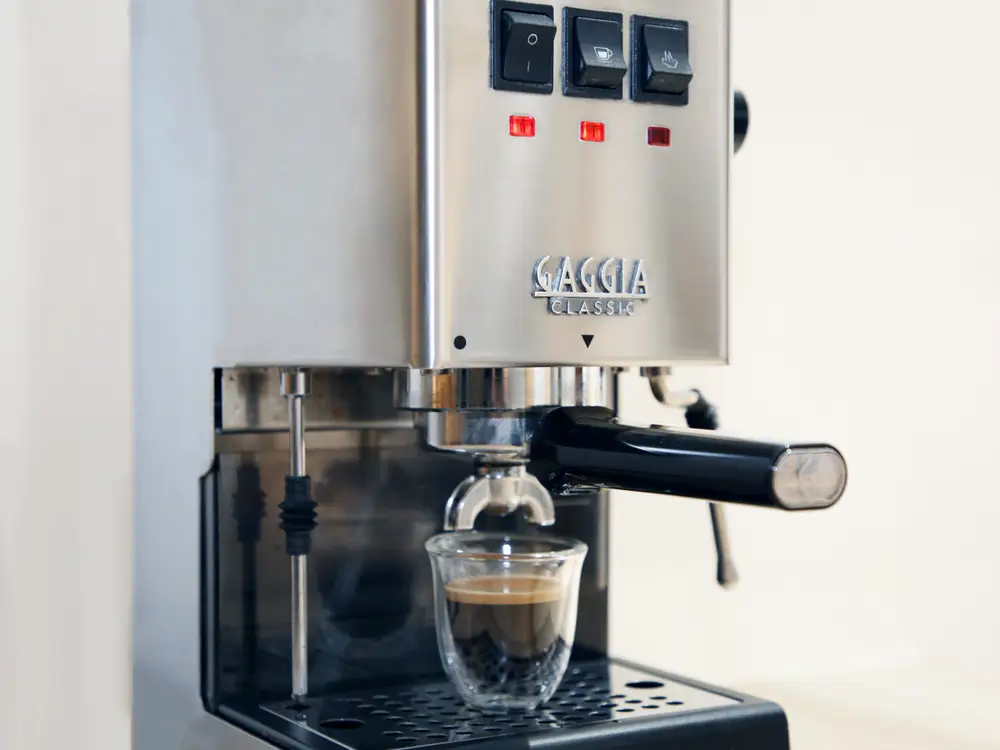
Best overall: Gaggia Classic Pro
Pros: Compact, simple interface, makes great espresso, relatively inexpensive
Cons: Serious learning curve, not much space under portafilter for different sized cups, requires dedicated espresso grinder and tamper
The recently improved Gaggia Classic Evo Pro is a no-frills, affordable machine for people who are serious about espresso. Don’t let its straightforward interface and simple design fool you: this machine can pull a full-bodied, flavorful shot of espresso.
With only three buttons to control it, the machine is simple to operate. Beyond the built-in steam wand, there are no real extra features. In the same vein, the machine doesn’t do much to hold your hand so there is a serious learning curve when dialing in parameters and figuring out how to pull a proper shot. But once you get used to it, the Classic Evo Pro produces stellar espresso.
The current 2023 model has a few notable upgrades, though they aren’t immediately apparent. Gaggia has gotten rid of the chrome plating in the older models and replaced it with a new grouphead made entirely of brass. Plus, the included portafilter is now made of stainless steel. The new boiler has a non-stick coating on the interior, which should help to avoid scaling and any leaching of minerals from the aluminum.
To make best use of this machine, a dedicated espresso grinder and one of the best tampers are both needed. The Classic Evo Pro comes packaged with a flimsy, plastic tamper that is a few millimeters short of properly fitting the portafilter, so we highly recommend an upgrade.

Best value: Café Affetto
Pros: Space-conscious design, built-in grinder, great frother
Cons: Grinder isn’t high-quality, doesn’t achieve true espresso (but better than pod machines)
An automatic espresso machine lies somewhere between a pod machine and a semi-automatic one; you can control the grind size and the extraction time, but the process isn’t fully hands-on. The Café Affetto is cheaper, smaller, and better at making espresso than most of the other automatic machines we’ve tried.
You’re not going to get the best grind with the Café’s built-in grinder, but you can still use the freshly roasted beans of your choice and get a shot of espresso (or something close to it) at the push of a button. Two standout features that make this one of the best espresso machines we’ve tried are the options for an Americano (or long black) and a custom “my cup” setting.
We frothed both whole milk and almond milk and noted that the frother worked every bit as well as those on most semi-automatic machines. We also like that the wand is removable and washable. Oftentimes, automatic machines will have a milk pitcher and hoses that you insert into the machine. This keeps everything very tidy and behind the scenes, but it’s too easy to forget the milk when it’s out of sight and end up with a rancid mess. This much more traditional layout where the frother is directly attached to the body is far more error-proof.

Best with a built-in grinder: Breville Barista Express Impress
Pros: Can use with a single hand, mess-free, tamp-assist, built-in pressure gauge
Cons: Dialing grind doser takes a little time, built-in grinder burrs can stick a little, probably not repairable outside of a two-year limited product warranty
In our quest to find the very best espresso machines with a built-in grinder, we’ve run tests on most of Breville’s espresso machines. While the Barista Express Impress may not be the fastest or most feature-equipped, it is the first machine you can operate from start to finish with one lone hand, mess-free.
Espresso is an inherently involved affair, from burr grinders whirring and overflowing, to gadgets galore and the occasional spewing portafilter (user error). But for the past month or so, I’ve been using the Barista Express Impress, writhing baby in arm, without so much as a lone ground to wipe away.
This is thanks to the assisted tamping and dosing system. The portafilter sits beneath the grinder, which doles out your grinds with a dosing button through a shoot (25 grind sizes, adjustable and programmable for single and double shots).
Breville’s proprietary “Impress” Puck System differentiates this machine from the original Barista Express. The built-in tamper operates via a lever on the left-hand side — it’s precalibrated and turns at precisely seven degrees, leaving a clean, even finish atop a perfectly formed puck.
The Express Impress also comes with all of the features and accessories you’ll find in any Breville machine: 15 bars of pressure (you only really need nine), a 67-ounce water tank (enough for a week’s worth of espresso), a convenient water spout, a half-pound sealed bean hopper, a steaming wand, a frothing pitcher, two double-walled and two pressurized portafilter baskets (a single- and double-shot size of each), and the Razor leveling tool. You’ll also find a brush with a clog-clearing pin and some descaling tablets.
There isn’t another machine that is as easy to operate one-handed or mess free. You’d have a hard time finding all of the quality features in this package tidily wrapped in stainless steel, ready to adorn any countertop in style.

Best portable: Flair Espresso
Pros: Budget-friendly, portable, comes with a case, five-year limited warranty
Cons: Takes longer to prep a shot, not great for making more than one or two espressos at a time
Manual espresso makers like the Flair Espresso are not only affordable, they offer more control than most budget machines that don’t allow you to adjust temperature or pressure.
Just know this before buying: using the Flair is slightly more time-consuming than making espresso with a machine by about two minutes. And, you’ll still need a grinder. Again, though, if time is a real constraint, you may want to look to pod machines, or perhaps the Breville Barista Pro, which offers a relatively quicker shot.
When I mentioned the Flair to Dan Kehn, former SCAA judge and founder of Home-Barista.com, he agreed that it’s an excellent bet for anyone new to the espresso world who wants to learn how to pull a full-bodied shot. Why? Again, it’s about control. You pour water directly from a kettle and adjust the pressure manually until you get a steady golden flow of thick, crema-rich java. Machines in the same price bracket as the Flair often start out with excessive pressure and end a little on the light side.
What makes this device relatively foolproof is the fact that the cylinder has a maximum water capacity of 60ml, so controlling extraction time for somewhere between 30 and 45 seconds (for espresso and more concentrated ristretto, respectively) is actually much easier, and you can get the hang of maintaining the right pressure pretty quickly. This maker weighs just under five pounds and it’s portable, which means you can use it anywhere so long as you have a way to boil water.
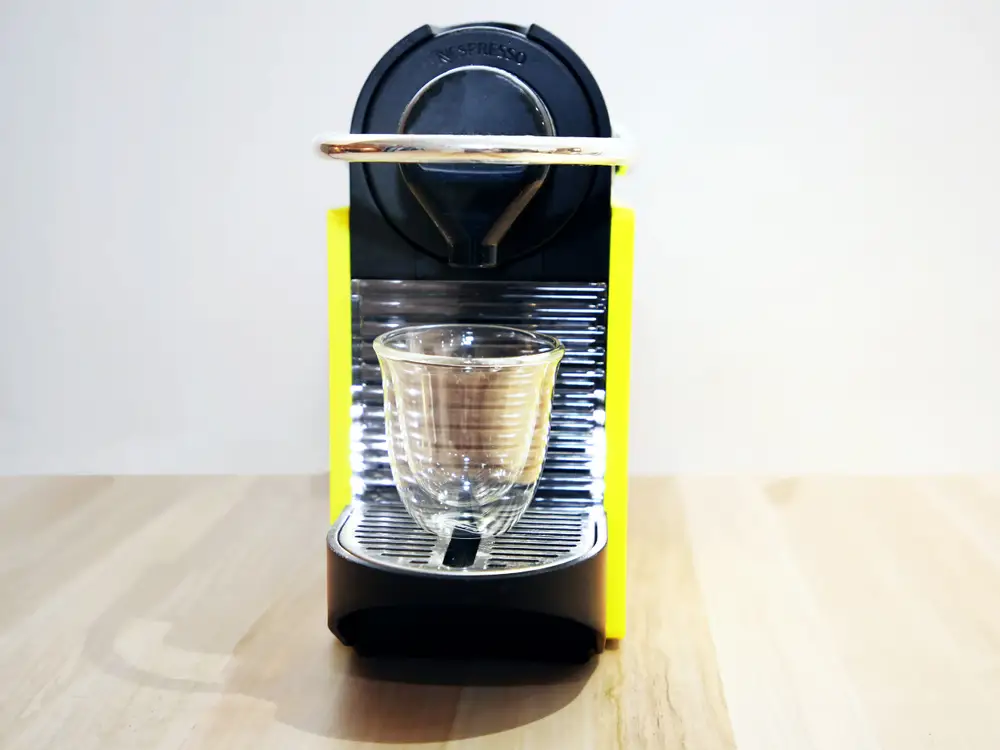
Best pod machine: Breville-Nespresso Pixie
Pros: Easy, convenient, affordable, small footprint
Cons: Pods can get expensive, on the lower end of espresso, pod grounds are not fresh
If you’re looking for the best espresso machine that uses pods, look no further. Turn the Nespresso Pixie on, pop in a pod, press a button, and in under a minute you will have an espresso-like drink, foamy crema and all. The Pixie has just two settings: one for espresso and one for a lungo, which is just a long, or more diluted pour of an espresso.
Nespresso claims that this machine offers 19 bars of pressure, but our TDS readings fell consistently around the 5% to 7% mark, which is just shy of espresso. In other words, you can’t expect “true” espresso from this machine, but you can count on a strong, frothy drink. That is, in fact, quite a feat. And with the added convenience and price point for the machine, we were willing to make an exception.
Further to that point, the machine is primed within 25 seconds. To save energy, it turns itself off automatically after nine minutes. These espresso machines come with a one-year limited warranty through Breville, but I have personally (and simultaneously) owned two for more than five years and haven’t had a single problem to date.
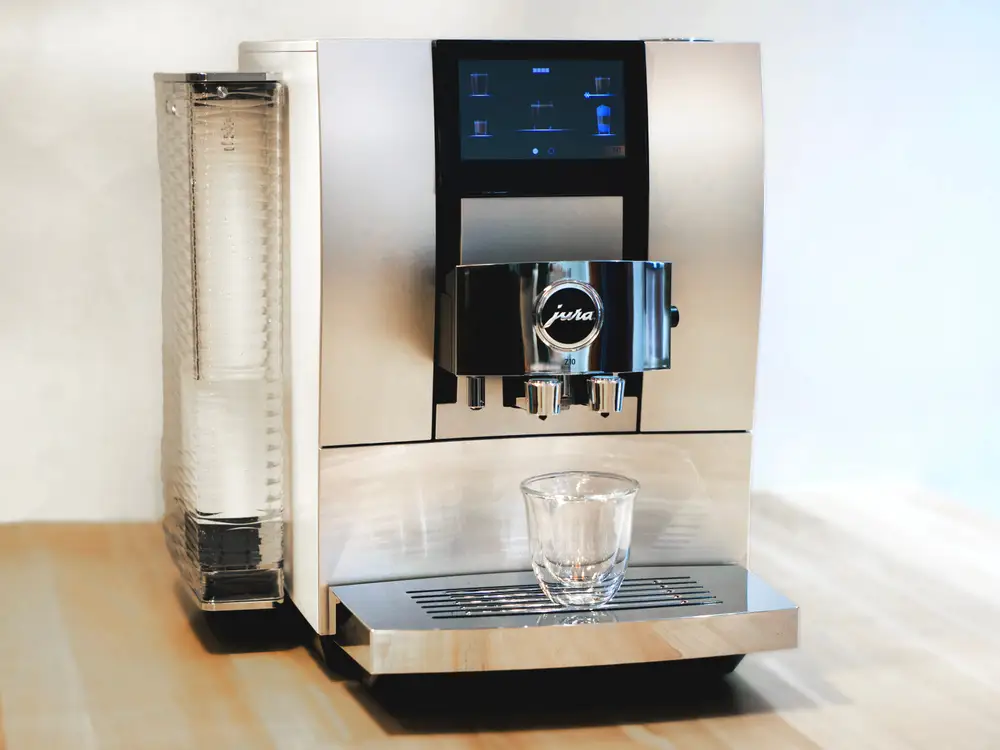
Best luxury automatic machine: Jura Z10
Pros: Fast, dynamic, highest-quality espresso we’ve tried from an automatic machine
Cons: Large, milk accessories sold separately
Jura’s Z10 is the best fully automatic espresso machine we’ve tested out of well over a dozen: it actually makes espresso and not a watered-down version. That’s largely thanks to Jura’s “product-recognizing grinder” (PRG), which automatically monitors grind size and adjusts in real time.
The machine is fully customizable, offering 24 pre-programmed espresso-based drinks and eight cold-brew-based beverages. However, we think calling it cold-brew is a bit of a stretch. Instead of steeping the grounds overnight, the machine produces coarse grounds, steeps them briefly in cold water, and then brews using pressure, creating something like nitro brew.
The Z10 is also compatible with an app (J.O.E.) so that you don’t even have to set foot in your kitchen to brew — just make sure there’s a cup in place ahead of time. You can set specialty preferences from your Apple Watch.
It’s also considerably more attractive than your run-of-the-mill automatic espresso machine, but that should be a given considering the price tag. Apart from the price, the real drawbacks are the size (over a foot wide and tall), the fact that the bean hopper is on top (so this likely isn’t fitting beneath a cabinet), and that the Cool Control and Stainless Steel Milk Pipe are sold separately and take up even more counter space.
But then anyone looking at a fully automatic espresso machine worth its weight and footprint can expect as much, four-figure price tag or not.

Best stovetop: Grosche Milano
Pros: Sturdy, high-quality parts, great for gas, electric, and camp stoves
Cons: Not great for induction stoves, corrosive, not dishwasher-safe
Grosche’s Milano is the most durable and functional food-grade aluminum Moka pot we’ve tried yet, thanks to its thick frame and a sturdy silicone handle that’s much less likely to melt than many other options on the market. This a big reason why it’s the best stovetop espresso maker we’ve tried.
Moka pots are designed to be placed above an open flame, and unless you’re working over an electric or induction stovetop, you need something that’s built to stand up to the heat, especially if your handle gets a little too close to your heat source.
The Milano has a silicone gasket, which won’t wear out as quickly as rubber ones and helps create better pressure when brewing. The low memory of silicone (you won’t start to find creases in it as you would with natural rubber) makes this gasket not only last longer, but create consistent pressure for a brew much closer to espresso.
You can choose the size best for your household, from 1-, 3-, 6-, 9-, and 12-cup models. Just know that “cup” here is not relative to either an 8-ounce cup or a demitasse (as espresso is generally measured), and its capacity falls somewhere between the two.
We still wish that someone mass-producing Moka pots these days would conjure up something that’s definitely fireproof (as was once a requisite of the humble little device). Still, Grosche is the brand coming closest to a Moka pot built for the long haul.
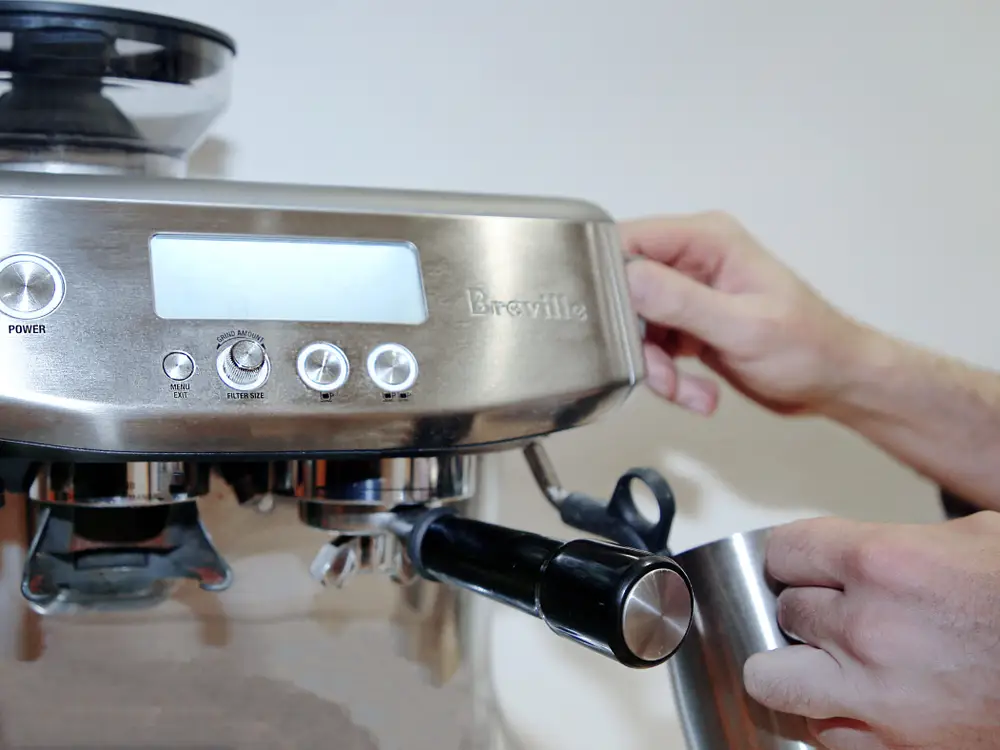
What to look for in an espresso machine
Cost: First things first, for most of us. What do you want to spend? This will eliminate a lot of potential considerations right away. For a quality machine that can build and maintain pressure and is designed to be both upgraded and repaired, you want to budget somewhere in the $500 range. Beneath that, we recommend a fully manual device or machine, or a stovetop Moka pot.
Size: A home espresso bar can pretty quickly overwhelm a kitchen. Consider the footprint of the machine you’re looking to buy relative to the countertop space you have. If you’re short on space, consider a pod machine or manual model.
Pressure: Any good espresso machine is going to be able to not just reach the required eight bars of pressure to make espresso, but maintain it. Beware machines that boast pressure levels. The cheapest of machines can reach 15 bars of pressure, but how well they maintain it is the key to a great cup of coffee.
Heating time: If warm-up time feels like a large consideration to you, consider a pod machine, or a semi-automatic Breville model. Otherwise, most espresso machines take at least a minute to heat up, and some manual options can take as long as 10 or 15 minutes.

How we test espresso machines
To gauge a machine’s performance, we put each through the following tests. In addition, we factored in pricing to determine a machine’s overall value.
- TDS measurements: We wanted to make sure we were getting true espresso, which is generally agreed to be at least somewhere between 7% and 12% total dissolved solids (TDS). Getting more involved, you’ll find some baristas reaching extraction percentages in the 20% range, but we stuck with the basics. To measure TDS, we used a device called the Atago Pocket Barista, which gave us concrete proof that some machines are better able to churn out a thicker, richer, more viscous potion without over-extracting than others.
- Taste tests: We held several side-by-side blind taste tests and used the freshest roasts we could get our hands on from Atlas Coffee Club, Stone Street Coffee Company, and Counter Culture Coffee. These taste tests involved dialing a grinder to prepare grounds for 30-second extraction times, then having five participants taste shots from four machines that became our final contenders.
- Consistency: We spent dozens of hours grinding and pulling shots from more than 10 pounds of fresh coffee beans. We paid close attention to the consistency of brewing to see if we could pull the same four shots in a row.
Who we consulted
To determine non-negotiable espresso machine features and narrow down my list of recommendations, I asked these coffee professionals to lend their expert advice:
- Lance Hedrick, Head of Sales at Arkansas’ Onyx Coffee Lab, runner-up at the 2020 United States Brewers Cup Championship, and a professional coffee trainer
- Dan Kehn, a former SCAA Barista judge and founder of Home-Barista.com
- Peter Giuliano, co-owner of Counter Culture Coffee and director of the Specialty Coffee Association of America (SCAA)
- Chi Sum Ngai and Kaleena Teoh of Coffee Project NY
- Jordan Rosenacker of Atlas Coffee Club

What do I need to make espresso?
Fresh coffee beans: The first thing you can do to make sure you’re making good coffee is to get the freshest whole beans you can find. If you’re buying months-old coffee and putting it through an espresso machine, you’re going to get a limited amount of the coveted foam, or crema, or any of the nuanced flavors associated with espresso.
A burr grinder: The coffee grinder you choose is possibly more important than the espresso machine or coffee maker itself. In our guide to coffee grinders, we like the Baratza Sette 270 for espresso.
Mineral water: The best water for making espresso, according to Lance Hedrick, is distilled water with an added mineral solution like this one from Third Wave Water. Otherwise, any charcoal water filter will do.
An espresso machine: You need a machine that can build and maintain even pressure between about six and nine bars. Machines can get expensive, but consider something pared-down, like our top recommendation, the Gaggia Classic Pro, or something completely automatic.
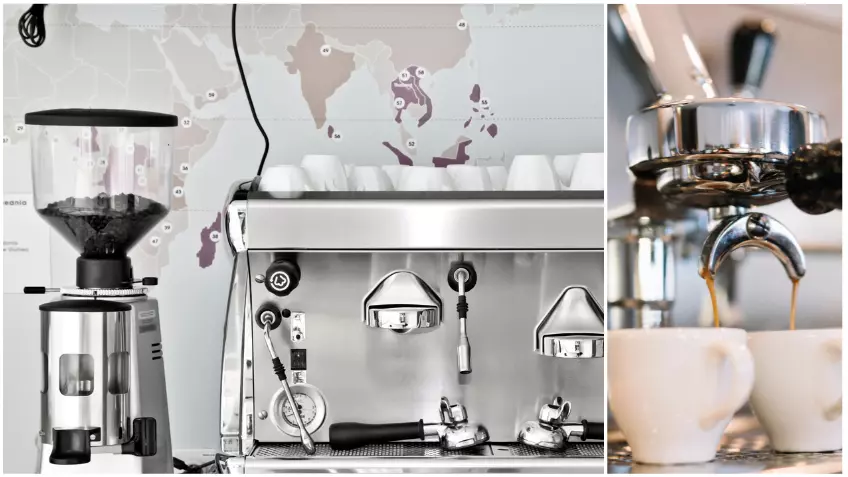
What are the different types of espresso?
- Normale, or standard espresso: A standard espresso is the most traditional form of the drink, and it’s usually defined by a 1:1.5 or 1:2 ratio of input (coffee in grams) to output (what ends up in your cup/demitasse), or by size at about one to 1.5 ounces (30ml-45ml).
- Ristretto: A ristretto is a 1:1 or 1:1.5 input-to-output ratio, or about three-quarters of an ounce (20ml to 25ml), and an even more concentrated version of espresso.
- Lungo: A lungo is a slightly diluted espresso, somewhere between three and four ounces (90ml to 120ml), which is between a normale and an Americano.
- Americano, or long black: An Americano is a shot of espresso diluted with hot water to fill out a cup.
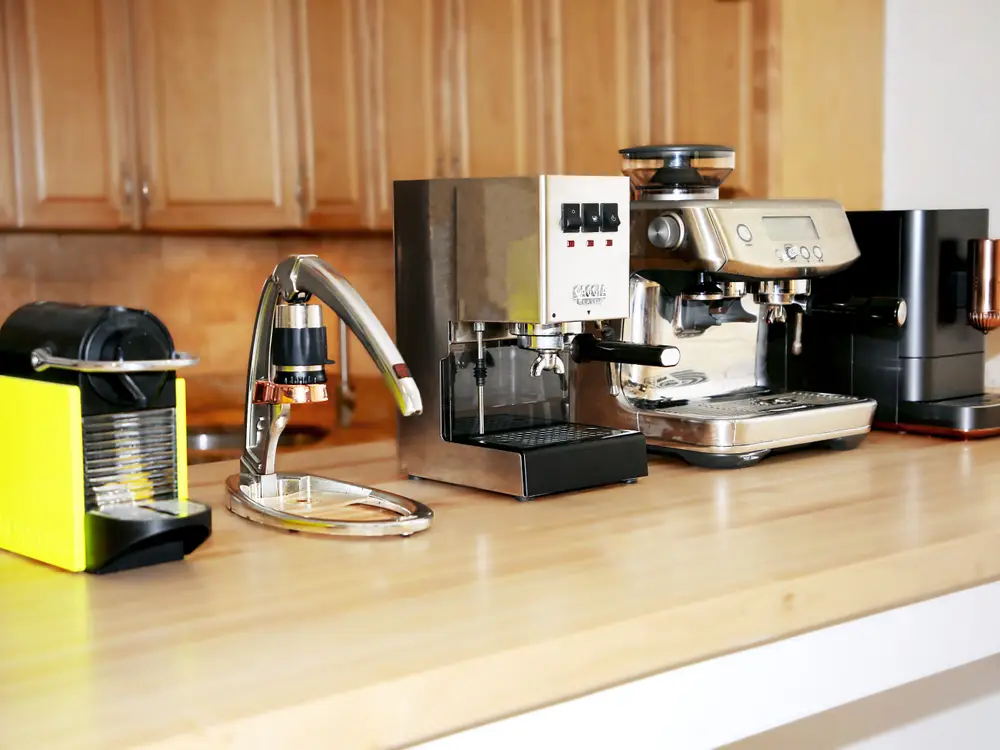
Espresso machine FAQs
Do I need an espresso machine?
Of course not, but there are few things as rewarding in the world of home coffee as achieving an immaculate shot of velvety espresso all on your own. On the flip side, if you need something quick and easy on your way out the door in the morning, consider the Nespresso system.
How do you clean an espresso machine?
Because all espresso machines are made differently, you’ll want to defer to the brand in order to properly clean your specific machine. The most essential tasks are regularly flushing and descaling with something like Urnex Cafiza powder, purging the steam wand, and backflushing on occasion.
A few basic tips and tricks, though: Running the machine without the portafilter in place helps flush the group head and keep it grit-free; Cleaning the drip tray regularly will keep mold, bacteria, and even fruit flies at bay; purging the steam wand after each use will keep dairy and non-dairy milk alternatives from getting stuck and developing bacteria; cleaning the water basin (if it’s not built-in) will keep your coffee tasting its best and the machine running smoothest.
Will customizing my machine help me make better espresso?
Yes, things like after-market shower screens, portafilter baskets, and bottomless portafilters (Lance Hedrick of Onyx Coffee Labs recommends this one) will help you achieve better shots and understand how and why your shots are coming out the way they are.
Changing out shower screens and portafilter baskets will also change the pressure and flow of your group head and offer a real upgrade to any machine. Hedrick recommends IMS for baskets and shower screens, and they’ve done well by us, too.
Why are espresso machines so expensive?
An espresso machine contains a powerful motor that pumps near-boiling water through a chamber and out the group head at high pressure. Everything needs to be expertly sealed so that it can contain piping-hot water under immense pressure, or the machine won’t work at all.
Can you make regular coffee with an espresso machine?
The closest thing you can get to drip coffee with an espresso machine is an Americano, or a long black. Simply pull a shot of espresso and then add whatever amount of hot water to fill out your cup. But you may want to save your money and buy a regular coffee machine. Consider a stovetop Moka pot to have on hand for an espresso-like drink.
Disclosure:
Written and researched by the Readnexpo team. We highlight products and services you might find interesting. If you buy them, we may get a small share of the revenue from the sale from our partners. We may receive products free of charge from manufacturers to test. This does not drive our decision as to whether or not a product is featured or recommended. We operate independently from our advertising team. We welcome your feedback. Email us at amitkumar@readnexpo.com




